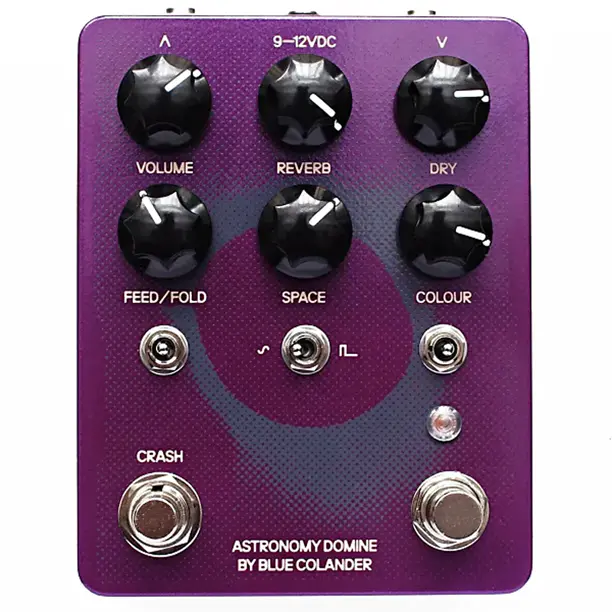
With its early Pink Floyd-inspired name, the Blue Colander Astronomy Domine can’t possibly be a regular pedal – and it’s not. Not only does this effect blend a great-sounding spring reverb with a dirt circuit, but it also provides several coloring options to create tones ranging from the classic to out-there stuff only heard before in Syd Barret’s head, including a momentary self-oscillation footswitch (Crash) whose speed can be tweaked via an internal trimmer.
Multiple color shaping controls, a wide range of dirt tones, and a reverb wavefolding circuit are some of the tools this pedal puts at your toe tips to open up the sonic doors leading to adventurous guitar tones.
Since we are not too familiar with wavefolding, we asked company owner and circuit designer Juliusz to gives us a short and sweet description of it, here’s his response:
Wavefolder is a circuit borrowed from a synthesisers gear, creating distortion by folding sound waveform instead of classic clipping, what provides unique harmonics and much different response compared to typical guitar distortion sound. In this pedal I implemented this treatment to the reverb channel. So I guess you could say that this Wavefolding reverb employs out of the ordinary circuit to shape a very unique character of dirty ambience tones.
Wavefolding is controlled through the Feed/Fold knob, which operates differently depending on the position of the similarly named toggle switch:
- Left position: sends the reverb signal back to the input
- Right position: sends the reverb signal to a wavefolder circuit
- Center position: sends the reverb signal to both the input and the wavefolder circuit
While the Space knob tweaks, as expected, the size of the reverb, rather counterintuitively the toggle switch under it deals with the preamp gain, delivering three distortion options:
- Left setting: (sine wave symbol) low gain with high headroom and no clipping
- Center setting: medium gain with soft clipping
- Right setting (square wave symbol) high gain with hard clipping
The Colour toggle, on the other hand, offers three voices for the Colour knob:
- Left setting: equally affects the reverb and the distortion circuits
- Center setting: boosts treble and cuts bass on reverb channel (pre-reverb)
- Right setting: applies treble boost on both channels at the input stage
Here’s the full list of controls.
VOLUME – overall volume of the pedal
REVERB – volume of reverb channel
DRY – volume of dry channel
FEED/FOLD knob – amount of reverb feedback, or wavefolder gain (depending on the switch setting)
SPACE knob – length and ‘size’ of reverb
COLOUR knob – overall tone control of the pedalFEED/FOLD switch – left setting sends reverb signal back to it’s input (feedback); right setting routes reverb signal to a wavefolder circuit; center setting selects both of these
SPACE switch – sets overall preamp gain, headroom and clipping behaviour – left setting (sine wave symbol) is low gain with high headroom and no clipping; center setting is medium gain with soft clipping; right setting (square wave symbol) is high gain with hard clipping
COLOUR switch – left setting keeps full frequencies range on both channels; center setting is treble boost and bass cut on reverb channel (pre-reverb); right setting engages additional treble boost on both channels (input stage)CRASH momentary footswitch – engages self-oscillation
Internal CRASH trimpot – sets how quick CRASH footswitch reaches max feedback
Internal DIP switch – sets hard clipping type of SPACE switch right position: ON is LED clipping (classic distortion sound – factory setting), OFF is diodes disconnected






















